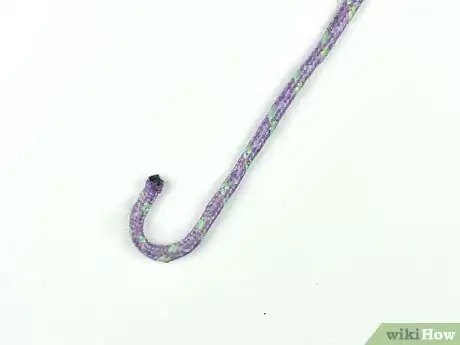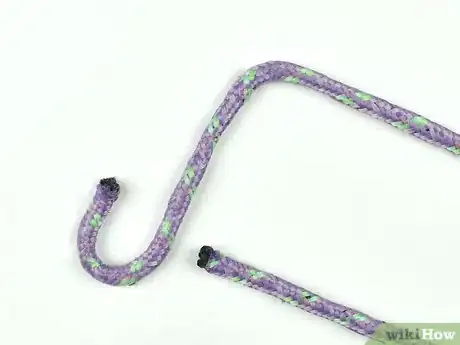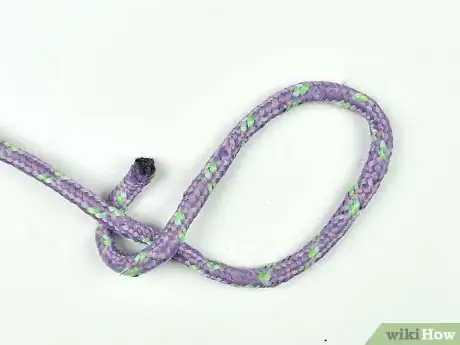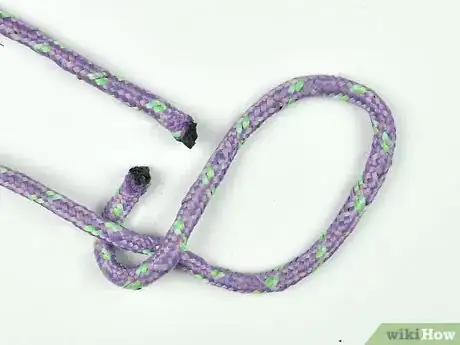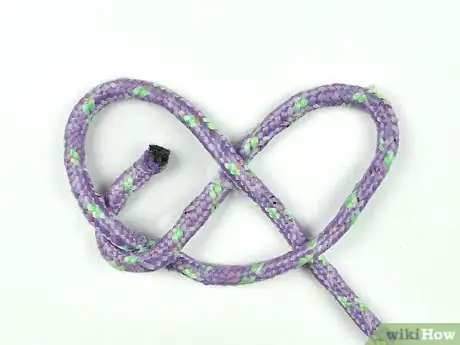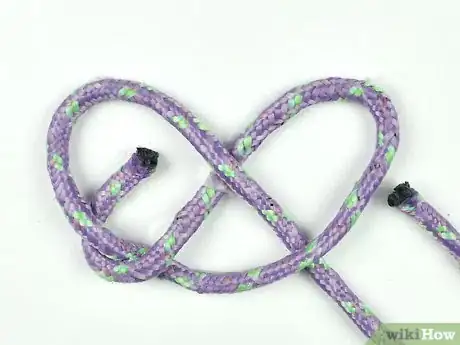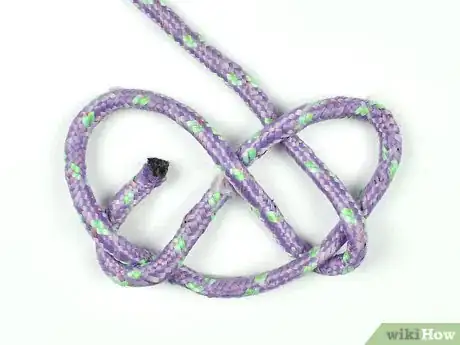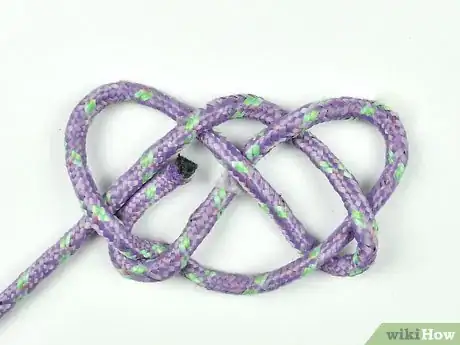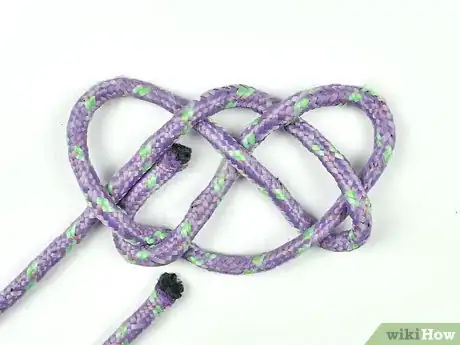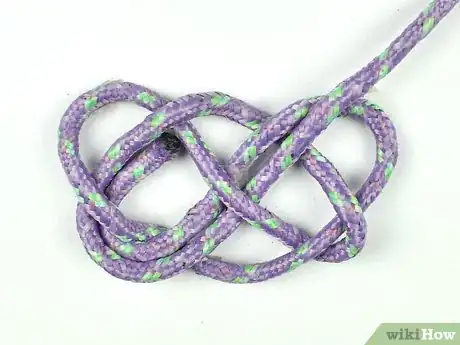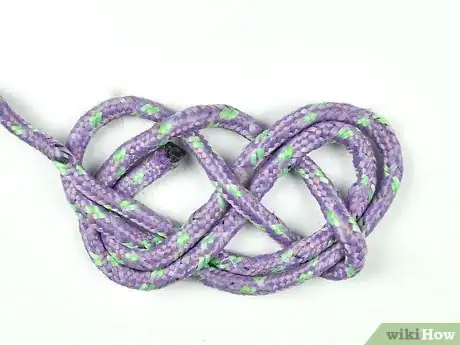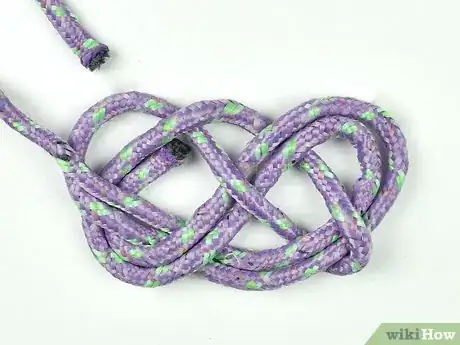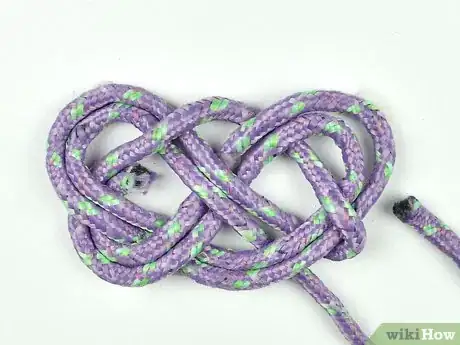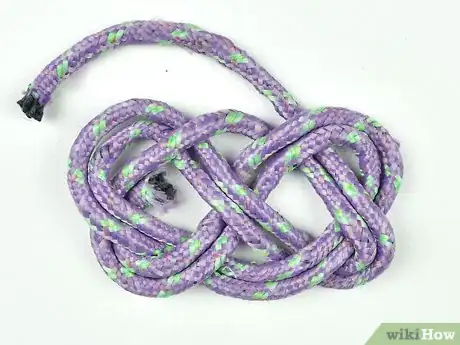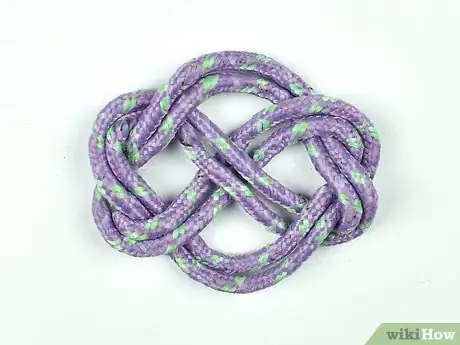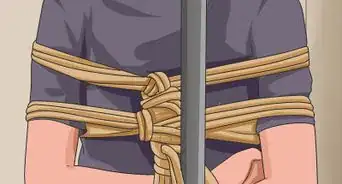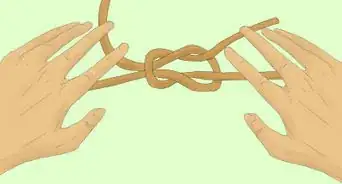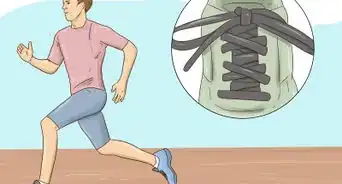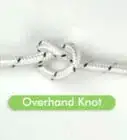This article was co-authored by wikiHow staff writer, Christopher M. Osborne, PhD. Christopher Osborne has been a wikiHow Content Creator since 2015. He is also a historian who holds a PhD from The University of Notre Dame and has taught at universities in and around Pittsburgh, PA. His scholarly publications and presentations focus on his research interests in early American history, but Chris also enjoys the challenges and rewards of writing wikiHow articles on a wide range of subjects.
The wikiHow Video Team also followed the article's instructions and verified that they work.
This article has been viewed 41,518 times.
Learn more...
Celtic knots look great for decorative purposes, but their intricate appearance makes them intimidating to attempt. However, once you master making the relatively basic Celtic square knot, creating Celtic heart knots or Celtic ring knots won’t be much of a challenge. Then, you can use rope to create a decorative mat or hot pad in a Celtic square knot pattern, or try your hand at a heart- or ring-shaped Celtic knot necklace.
Steps
Starting a Celtic Square Knot
-
1Create a hook shape on the table with your section of rope. Especially if you’re a beginner, start with a section of braided rope that’s about 2 ft (61 cm) long and around 1 in (2.5 cm) in diameter. Lay the rope on the table so it makes a left-facing hook at the bottom left corner of the table, and the straight end points toward the upper right corner.[1]
- The rope will look somewhat like an italicized letter “J” with an elongated straight section.
-
2Loop the rope’s leading end around to the right at the base of the hook. Make the loop to the right of the original J-shape, and point the tip of the rope’s leading end slightly below where the curve of the hook begins.[2]
- The “leading end” is the end of the rope that you’ll be working with throughout the process—that is, the end of the rope that you’ll be feeding into, out of, and through the developing knot.
- The “standing end” or “starting end” is the end of the rope that remains in the same place throughout the process. In this case, this is the end of the rope that makes the tip at the end of the hook shape.
Advertisement -
3Pass the leading end under and then over the curve of the hook. Go underneath the first section of rope you encounter, which is on the shaft side of the hook. Then, take the leading end straight across the gap in the hook and go over the rope that makes the tip side of the hook.[3]
- Leave around 0.25 in (0.64 cm) of the starting end of the rope (the hook tip) exposed above the leading end that crosses over it.
-
4Curl the leading end up and around so it’s a little above the curve of the hook. Point the leading end to the left of the shaft of the original hook, about 0.5 in (1.3 cm) above where the curve of the hook begins.[4]
- At this point, the rope will look a little like a heart shape with an oversized left side.
-
5Thread the leading end over then under the rope to create a pretzel shape. Go over the shaft of the original hook shape, then under the rope at the outer edge of the first loop you made. [5]
- Your rope should now look like a pretzel with a long tail extending from its bottom right side!
-
6Loop the leading end up and around to the right side of the pretzel shape. Curve the leading end back around to point it at the center of the loop that makes up the right side of your pretzel shape. But don’t feed it into the pretzel loop quite yet.[6]
Completing Your Celtic Square Knot
-
1Weave the leading end through the right loop of the pretzel. Go over the rope that makes the outside of the right pretzel loop, then go straight through the center of the loop, and finally go under the rope at the top left portion of the right pretzel loop.[7]
- The leading end should be in the middle of the V-shaped gap at the top of the pretzel shape—that is, the gap between the right and left loops.
-
2Feed the leading end through the left loop of the pretzel. Still within the V-shaped gap at the top of the pretzel, curve the leading end so it’s facing down and left instead of up and left. Then, feed it over the first rope you encounter to go into the left pretzel loop. Keep going straight through the loop, then exit it by going under the rope that makes its lower left border.[8]
- The leading end should now be pointed toward the bottom left corner of the table.
-
3Turn the leading end around so it’s pointed toward the center loop. Create a downward curve in the leading end so that it points back at the pretzel shape. Aim it halfway between the bottom curve and the bottom left corner of the center loop of the pretzel.[9]
-
4Thread the leading end through the ropes that make the center loop. Go over the rope to enter the center loop, keep going straight through the loop, and exit it by going under the rope that separates the center and right loops of the pretzel.[10]
- Keep the leading end centered within the center and right loops, pointed toward the top right corner of the table.
-
5Guide the leading end out of the pretzel shape, then hook it back around. Go over the rope that’s now in the center of the right pretzel loop, and also over the rope that defines the outer border of the right pretzel loop. Now that you’ve exited the pretzel shape, bring the leading end down and around so it’s pointed back toward the pretzel again.[11]
- The tip of the leading end should be just outside the top right edge of the right pretzel loop.
-
6Follow the U-shaped curve of the original pretzel shape with the leading end. Feed the leading end over the rope to go back into the right loop of the pretzel, then keep it just inside the rope that defines the border of the right and bottom sides of the pretzel shape.[12]
- As you follow the path of the border rope, go under the first rope you encounter, over the second, under the next 2 side-by-side ropes, and finally over the 2 adjacent ropes that meet at the top left side of the pretzel shape.
- You’ve essentially just doubled the thickness of the border of the pretzel shape, starting at its top right side, then going down, around, and back up before exiting at its top left side.
-
7Curl the leading end back toward the left loop of the original pretzel. Turn the leading end from facing toward the top left corner of the table to facing toward the bottom right corner of the table. The tip of the leading end should be right outside the top left side of the pretzel shape.[13]
-
8Weave the leading end through the center from top left to bottom right. Keep the leading end up against but just below the rope that already runs diagonally inside the pretzel shape from top left to bottom right. As you proceed, go under the first rope you encounter, over the next 2 side-by-side ropes, and then under the final 2 side-by-side ropes to exit the knot at its bottom right.[14]
- Your knot will now look a bit like 2 intertwined pretzels, one pointing up and the other pointing down. This is the beginning of the classic Celtic knot shape!
-
9Loop the leading end up and around to the knot’s right side. Redirect the leading end from pointing toward the bottom right of the table to pointing toward the top left of the table. Point the tip of the leading end just above the rope that curves from under the lower left side of the knot and goes diagonally up and left to the top center of the knot.[15]
- When you feed the leading end back into the knot, you’ll want to keep it adjacent to but just above this rope.
-
10Feed the leading end through the top right, then around above the knot. Go over the first 2 side-by-side ropes you encounter to enter the knot, keep going straight through the top right section of the knot, and then exit the knot just right of top-center by going under the 2 side-by-side ropes.[16]
- Once you’ve exited the knot, curve the path of the leading end so it goes from facing toward the top left corner of the table to facing toward the bottom left corner.
-
11Thread the leading end through the top left corner of the knot. At the top left of the knot, you’ll see a small gap between the side-by-side outer ropes and a single rope that runs diagonally from top-center to center-left. Feed the leading end into and out of this gap by going over the 2 side-by side ropes to enter the knot, then under the 2 side-by-side ropes to exit the knot.[17]
- With practice, you’ll be able to tie your knot so that you run out of rope exactly at this point, so that the leading edge is “hidden” under the last set of side-by-side ropes that you went under. Until you reach that point, you can simply trim off the excess rope with scissors.
Adjusting a Square Knot to Make Other Celtic Knots
-
1Pinch and tug the base of the square knot to make a Celtic heart knot. Because the Celtic square knot isn’t an overly tight knot, you can reshape it a bit without much trouble. If you want the knot to have more of a heart shape, just use your thumb and index finger to pinch the bottom of the knot together a little more. This will give the overall knot more of a heart shape.[18]
- You can also tug down gently on the bottom center of the knot to help define the heart shape.
- You can find directions online for tying a heart knot from scratch (instead of starting with a square knot), but you won’t notice much difference in the end—and the square knot is a useful “master knot” for various Celtic knot forms.
-
2Create a “donut hole” in the square knot’s center to make a Celtic ring knot. The center section of a square knot has 2 pairs of double ropes crossing over each other in an X-shape, with 4 diamond-shaped holes surrounding them. When you finish the square knot, make the bottom hole larger by manipulating the knot with your hands.[19]
- Use your fingers to enlarge the bottom hole, and tug on the outer ropes of the knot to spread everything into a ring shape.
- By doing so, you’ll end up with a ring-shaped knot with a “donut hole” in the middle.
- You can also create a Celtic ring knot from scratch with a somewhat different knot-tying process, but the end result will be very similar.
-
3Use thinner rope and leave longer rope ends to make a necklace. Celtic knots—square, heart, ring, or other types—make great designs for simple string necklaces, and are easy to make once you get the hang of the knot. Simply make the following adjustments:[20]
- Use a longer, thinner piece of string instead of braided rope.
- Keep at least 1 ft (30 cm) of excess string beyond the starting point of the knot—that is, beyond the tip of the original hook shape that starts the knot.
- Likewise, keep at least 1 ft (30 cm) of excess string on the leading end of the string as you make the knot.
- When you’re finished, tie excess string on both the starting and leading ends to make the “chain” for the necklace. The Celtic knot will be the design in the middle.
-
4Stitch or hot glue the ends of the rope in place. If you don’t secure the starting and leading ends of the rope in place, the knot will eventually unravel. Either stitch them to the sections of rope that they’re hidden under, or apply a dab of hot glue to each and stick them in place under the ropes.[21]
- The starting and leading ends of the rope should be nearly side-by-side on the left side of the knot, but hidden beneath the ropes that make up the knot.
- If you've used fairly thick braided rope, this square knot can serve as a nice decorative mat or hot pad.
References
- ↑ https://www.animatedknots.com/celtic/index.php
- ↑ https://www.animatedknots.com/celtic/index.php
- ↑ https://www.animatedknots.com/celtic/index.php
- ↑ https://www.animatedknots.com/celtic/index.php
- ↑ https://www.animatedknots.com/celtic/index.php
- ↑ https://www.animatedknots.com/celtic/index.php
- ↑ https://www.animatedknots.com/celtic/index.php
- ↑ https://www.animatedknots.com/celtic/index.php
- ↑ https://www.animatedknots.com/celtic/index.php
- ↑ https://www.animatedknots.com/celtic/index.php
- ↑ https://www.animatedknots.com/celtic/index.php
- ↑ https://www.animatedknots.com/celtic/index.php
- ↑ https://www.animatedknots.com/celtic/index.php
- ↑ https://www.animatedknots.com/celtic/index.php
- ↑ https://www.animatedknots.com/celtic/index.php
- ↑ https://www.animatedknots.com/celtic/index.php
- ↑ https://www.animatedknots.com/celtic/index.php
- ↑ https://snapguide.com/guides/tie-a-celtic-heart-knot/
- ↑ https://www.youtube.com/watch?v=Sj7aPTn55QY
- ↑ https://snapguide.com/guides/tie-a-celtic-heart-knot/
- ↑ https://www.animatedknots.com/celtic/index.php
